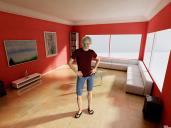Composite test
This is a composite test I rendered in Cinema 4d. There's some mistakes in it, but all and all the result are amazing for little work.
The room is a photograph from the internet ( google interior room) and the hair was created in Cinema 4d and converted to polygons. The morphs to make Genesis look a bit more realistic were done in Zbrush.
Its got a ways to go and while not really photo realistic, it could make a descent composition for many purposes.


CompositeTest.jpg
800 x 600 - 159K


Comments
For very little effort it is quite good IMHO. Can you imagine if you threw a couple of days days it what you could do.
There's a good tutorial on compositing in Cinema 4d at http://www.youtube.com/watch?v=DwPDFMddu1s
I was amazed at how well modeled figures blend in and had to try it with Daz figures. I want to expand it further to work with sibl sets but I'm having trouble making invisible shadow catchers in Cinema 4d. The plane that catches the shadow in the above composite is visible, its just textured frontaly with the room picture. If I can figure out how to make an invisible shadow catcher, complex animations in the sibl environment becomes possible.
3d has changed so much since the 90's ! :) C4D is like pliable reality.
Thanks for the link that is a great tutorial - trying to work out now how to do the same in DAZ Studio - I know how to use an image fo rthe background but can't get the camera and plane to line up correctly...
Not sure what the "s" stands for in sibl, but I'm guessing the "ibl" stands for Image Based Lighting. In C4D what is the shadow catcher catching? I know in Carrara the shadow catcher works great when not using global illumination or IBL. When using IBL, or GI it "catches" the complex lighting those functions create, causing the object used as a shadowcatcher to become visible. It still retains it's alpha channel, but picks up a colored hue.
A work around might be to set up a light to mimic the main shadows in the scene, turn off the IBL and render a shadow pass with the shadow catcher (I'm assuming C4D can render different layers). Next, remove or hide the shadowcatcher, render the scene with the IBL. Use the shadow layer to composite in post with the IBL layer.
Not sure what the "s" stands for in sibl, but I'm guessing the "ibl" stands for Image Based Lighting. In C4D what is the shadow catcher catching? I know in Carrara the shadow catcher works great when not using global illumination or IBL. When using IBL, or GI it "catches" the complex lighting those functions create, causing the object used as a shadowcatcher to become visible. It still retains it's alpha channel, but picks up a colored hue.
A work around might be to set up a light to mimic the main shadows in the scene, turn off the IBL and render a shadow pass with the shadow catcher (I'm assuming C4D can render different layers). Next, remove or hide the shadowcatcher, render the scene with the IBL. Use the shadow layer to composite in post with the IBL layer.
The "" in SIBL stands for smart - smart image based lighting.
Check it out - http://www.hdrlabs.com/sibl/index.html
Very interesting.
I was re-reading the post where you mention you couldn't make an invisible shadow catcher. I don't know where it is in C4D, but in Carrara the Shadow catcher is found in the Shader Room under lighting models. It can be applied to anything, from a plane to a model.
With the price of C4D hopefully the Shadow catcher is more advancedthan Carrara's. Carrara's will catch shadows and act as a mask. That's pretty much it. There's no way to catch reflections for instance. There's also the issue I mentioned of catching GI, which, when I read your post made me think that was what was happening in your case.